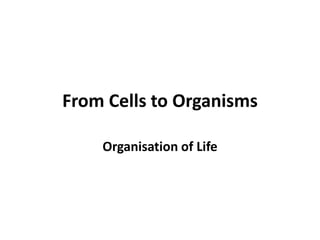Anatomy - Topic 1 (A) From Cells to organisms
•Download as PPT, PDF•
0 likes•49 views
This document discusses the levels of organization of living things from cells to organisms. It explains that cells are the basic unit of structure and function, and that multicellular organisms have cells that specialize and divide labor. Tissues are groups of similar cells that work together, organs contain different tissue types and perform specific functions, and organ systems are groups of organs that work cooperatively. The highest level of organization is the organism, a complete living thing made of these organized levels. Examples of human organ systems that work interdependently include the digestive, circulatory, respiratory, reproductive and excretory systems.
Report
Share
Report
Share

Recommended
More Related Content
What's hot
What's hot (17)
Similar to Anatomy - Topic 1 (A) From Cells to organisms
Similar to Anatomy - Topic 1 (A) From Cells to organisms (20)
Recently uploaded
Recently uploaded (20)
pumpkin fruit fly, water melon fruit fly, cucumber fruit fly

pumpkin fruit fly, water melon fruit fly, cucumber fruit fly
Thyroid Physiology_Dr.E. Muralinath_ Associate Professor

Thyroid Physiology_Dr.E. Muralinath_ Associate Professor
development of diagnostic enzyme assay to detect leuser virus

development of diagnostic enzyme assay to detect leuser virus
Call Girls Ahmedabad +917728919243 call me Independent Escort Service

Call Girls Ahmedabad +917728919243 call me Independent Escort Service
FAIRSpectra - Enabling the FAIRification of Analytical Science

FAIRSpectra - Enabling the FAIRification of Analytical Science
chemical bonding Essentials of Physical Chemistry2.pdf

chemical bonding Essentials of Physical Chemistry2.pdf
Pests of mustard_Identification_Management_Dr.UPR.pdf

Pests of mustard_Identification_Management_Dr.UPR.pdf
❤Jammu Kashmir Call Girls 8617697112 Personal Whatsapp Number 💦✅.

❤Jammu Kashmir Call Girls 8617697112 Personal Whatsapp Number 💦✅.
High Class Escorts in Hyderabad ₹7.5k Pick Up & Drop With Cash Payment 969456...

High Class Escorts in Hyderabad ₹7.5k Pick Up & Drop With Cash Payment 969456...
High Profile 🔝 8250077686 📞 Call Girls Service in GTB Nagar🍑

High Profile 🔝 8250077686 📞 Call Girls Service in GTB Nagar🍑
Anatomy - Topic 1 (A) From Cells to organisms
- 1. From Cells to Organisms Organisation of Life
- 2. Levels of Organization • Cell—Basic unit of structure and function in organisms. – Some organisms, like bacteria and protists, are unicellular (made entirely of one cell). – Some organisms, like fungi, plants, and animals, are multicellular (made of many cells). – In multicellular organisms, cells exhibit cell specialisation. They take on specific jobs and look different from each other. – The cells also exhibit division of labor. They split up the work of the organism.
- 4. Levels of Organization • Tissues—Groups of similar cells that work together to perform a specific function. –4 major tissue types in animals • Epithelial tissue • Connective tissue • Muscle tissue • Nervous tissue
- 5. Levels of Organization • Organs—structures made of different types of tissues that work together to perform a specific function. – Examples • Heart • Lungs • Stomach • Small intestine • Liver • Large Intestine • Gall Bladder • Plant Roots • Plant Stems • Plant Leaves
- 6. Levels of Organization • Organ Systems—Groups of organs that work together to perform a specific function. –Examples: • Digestive system • Circulatory system • Respiratory system • Nervous system • Muscular system • Skeletal system • Integumentary system (skin) • Vascular system in plants
- 7. Levels of Organization • Organism—A complete, individual living thing. • Examples: – A single person – A single plant – A single bacterium – A single protist
- 8. Membrane Bounded Organelles in a Eukaryotic Cell • Eukaryotic cells contain many membrane-bound organelles. An organelle is an organized and specialized structure within a living cell. • The organelles include: – The nucleus – Ribosomes – Endoplasmic Reticulum – Golgi Apparatus – Vacuoles – Lysosomes – Mitochondria – In plants, chloroplasts.
- 9. 9 Organization of Vertebrate Body • Tissues are groups of cells that are similar in structure and function • In humans, there are four primary tissues: – Epithelial – Connective – Muscle – Nerve • Organs are combinations of different tissues that form a structural and functional unit
- 10. 10 Organization of Vertebrate Body • Organ systems are groups of organs that cooperate to perform the major activities of the body • The human body contains 11 principal organ systems • The five main organ systems that we will be focusing on in this unit are: – The Respiratory System – The Circulatory System – The Reproductive System – The Digestive System – The Excretory System
- 11. 11 Organization of Human Body NO Thank you!
- 12. 12 Digestive System NO Thank you! The organs or parts of the body that work together to break down food into a smaller, more useable form.
- 13. 13 Circulatory System NO Thank you! The system that carries oxygen and nutrients to all cells in the body and takes wastes away from the cells; it consists of the heart, blood vessels and blood.
- 14. 14 Respiratory System NO Thank you! The system involved in the inhalation of and diffusion of oxygen into the blood stream, and the removal of carbon dioxide from the body via exhalation
- 15. Excretory System The system responsible for the removal of excess water and waste from cell reactions in the body
- 16. Reproductive System The male and female reproductive systems are responsible for the production of sperm and ova (eggs), the fertilisation of ova by sperm, and the gestation of a fertilised ova into a foetus (unborn baby)
